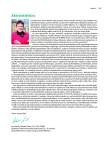-
Medical journals
- Career
The SPRINT study – the outcomes of the most important study over the recent period focused on hypertension
Authors: Miroslav Souček
Authors‘ workplace: II. interní klinika LF MU a ICRC FN u sv. Anny v Brně
Published in: Vnitř Lék 2016; 62(11): 933-937
Category:
Overview
When treating systolic hypertension we do not know the optimum blood pressure which leads to the reduction of cardiovascular events and cardiovascular and total mortality. The results of the ACCORD study, when comparing intensive treatment of systolic blood pressure < 120 mm Hg and standard treatment < 140 mm Hg, did not lead to affecting the primary target for patients with diabetes mellitus. In the autumn last year the SPRINT study was presented and published, showing favourable impact on the combined primary target, which involved myocardial infarction, other acute coronary syndromes, stroke, heart failure or death from cardiovascular causes during intensive treatment of systolic blood pressure, i.e. < 120 mm Hg, but on the other hand with a statistically significant incidence of secondary effects (hypotension, syncope, renal impairment or failure).
Key words:
target values – hypotension – cardiovascular events – systolic blood pressure
Sources
1. Franklin SS, Jacobs MJ, Wong ND et al. Predominance of isolated systolic hypertension among middle-aged and elderly US hypertensives: analysis based on National Health and Nutrition Examination Survey (NHANES) III. Hypertension 2001; 37(3): 869–874.
2. Chobanian AV, Bakris GL, Black HR et al. The seventh report of the Joint National Committee on Prevention, Detection, Evaluation, and Treatment of High Blood Pressure: the JNC 7 Report. JAMA 2003; 289(19): 2560–2572. Erratum in JAMA 2003; 290(2): 197.
3. Hsu CY, McCulloch CE, Darbinian J et al. Elevated blood pressure and risk of end-stage renal disease in subjects without baseline kidney disease. Arch Intern Med 2005; 165(8): 923–928.
4. Sundström J, Arima H, Jackson R et al. Effects of blood pressure reduction in mild hypertension: a systematic review and meta-analysis. Ann Intern Med 2015; 162(3): 184–191. Dostupné z DOI: <http://dx.doi.org/10.7326/M14–0773>.
5. Neal B, Mac Mahon S, Chapman N. [Blood Pressure Lowering Treatment Trialists’ Collaboration]. Effects of ACE inhibitors, calcium antagonists, and other blood – pressure – lowering drugs: results of prospectively designed overview of randomised trials. Lancet 2000; 356(9246): 1955–1964.
6. Psaty BM, Smith NL, Siscovick DS et al. Health outcomes associated with antihypertensive therapies used as first-line agents: systematic review and meta-analysis. JAMA 1997; 277(9): 739–745.
7. Lewington S, Clarke R, Qizilbash N et al. Age-specific relevance of usual blood pressure to vascular mortality: a meta-analysis of individual data for one million adults in 61 prospective studies. Lancet 2002; 360(9349): 1903–1913.
8. Beckett NS, Peters R, Fletcher AE et al. Treatment of hypertension in patients 80 years of age or older. N Engl J Med 2008; 358 : 1887–1898. Dostupné z DOI: <http://dx.doi.org/10.1056/NEJMoa0801369>.
9. Verdecchia P, Staessen JA, Angeli F et al. Usual versus tight control of systolic blood pressure in non-diabetic patients with hypertension (Cardio.Sis): a open-label randomised trial. Lancet 2009; 374(9689): 525–533. Dostupné z DOI: <http://dx.doi.org/10.1016/S0140–6736(09)61340–4>. Erratum in Lancet 2009; 374(9693): 880.
10. Cushman WC, Evans GW, Byington RP et al. [ACCORD Study Group]. Effect of intensive blood pressure control in type 2 diabetes mellitus. N Engl J Med 2010; 362 : 1575–1585. Dostupné z DOI: <http://dx.doi.org/10.1056/NEJMoa1001286>.
11. Benavente OR, Coffey CS, Conwit R et al. [SPS3 Study Group]. Blood-pressure targets in pacients with recent lacunar stroke: the SPS3 randosed trial. Lancet 2013; 382(9891): 507–515. Dostupné z DOI: <http://dx.doi.org/10.1016/S0140–6736(13)60852–1>. Erratum in Lancet 2013; 382(9891):506.
12. Wright JT, Williamson PK, Snyder JK et al. [The SPRINT Group]. A Randomised Trial of Intensive versus Standard Blood-Pressure Control. N Engl J Med 2015; 373(22): 2103–2116. Dostupné z DOI: <http://dx.doi.org/10.1056/NEJMoa1511939>.
13. Perkovic V, Rodgers A. Redefining Blood-Pressure Targets – SPRINT starts the Marathon. N Engl J Med 2015; 373(22): 2175–2178. Dostupné z DOI: <http://dx.doi.org/10.1056/NEJMe1513301>.
14. Drazen JM, Morrissey S, Campion EW et al. A SPRINT to the Finish. N Engl J Med 2015; 373(22): 2174–2175. Dostupné z DOI: <http://dx.doi.org/10.1056/NEJMe1513991>.
15. Cushman WC, Evans GW, Byington RP et al. [ACCORD Study Group]. Effect of intensive blood pressure control in type 2 diabetes mellitus. N Engl J Med 2010; 362 : 1575–1585. Dostupné z DOI: <http://dx.doi.org/10.1056/NEJMoa1001286>
16. Cífková R. Změní výsledky studie SPRINT dosavadní doporučení pro léčbu hypertenze? Hypertenze a kardiovaskulární prevence 2016; 5(1): 15–17.
17. Filipovský J, Widimský J, Ceral J et al. Diagnostické a léčebné postupy u arteriální hypertenze – verze 2012. Hypertenze a kardiovaskulární prevence 2013; 1(3)3 : 1–15.
18. Souček M, Widimský J, Lánská V. Control of hypertension in patients with hypertension, diabetes an impaired fasting glucose by Czech primary care physicians. Kidney Blood Press Res 2006; 29(6): 366–372.
Labels
Diabetology Endocrinology Internal medicine
Article was published inInternal Medicine

2016 Issue 11-
All articles in this issue
- Hypertension and hypercholesterolemia in the Czech population
- Genetic determination of dyslipidemia – What tell us the results of genome-wide association studies?
- Molecular genetics of hypercholesterolemia
- Hyperlipoproteinemia in children
- Hyperlipoproteinemia and dyslipidemia as rare diseases. Diagnostics and treatment
- Severe familial hypercholesterolemia treatment
- How to deal ugly twins, LDL-cholesterol and lipoprotein (a)
- Diabetes and dyslipidemia: Why are they so closely related?
- A diet suitable for patients with dyslipidemia and metabolic syndrome
- Uric acid as a risk factor for cardiovascular diseases
- Familial hypercholesterolemia in the Czech Republic in 2016
- Notes on the HOPE-3 study
- The SPRINT study – the outcomes of the most important study over the recent period focused on hypertension
- Internal Medicine
- Journal archive
- Current issue
- Online only
- About the journal
Most read in this issue- A diet suitable for patients with dyslipidemia and metabolic syndrome
- Hyperlipoproteinemia in children
- Hyperlipoproteinemia and dyslipidemia as rare diseases. Diagnostics and treatment
- Uric acid as a risk factor for cardiovascular diseases
Login#ADS_BOTTOM_SCRIPTS#Forgotten passwordEnter the email address that you registered with. We will send you instructions on how to set a new password.
- Career

